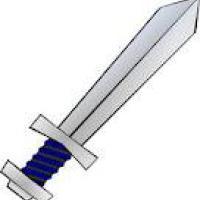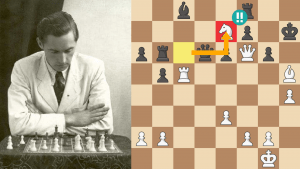
No Guts, No Glory!
White had been trying to keep the position closed since he feared activating black’s two Bishops if he opened things up. The first and foremost question in any position should be, “Where is my play coming from? Which side of the board should I play on, and which side of the board will my opponent play on?”
At the moment black’s Bishops aren’t doing anything. The d6-Bishop in particular is more of a tall-pawn than a Bishop. Since the center is locked, and since both sides need to get their Rooks into the game, pawn breaks are necessary to gain more space in a particular area and to open files for the Rooks. Here are the possible pawn breaks:
1) QUEENSIDE: White can prep for a b3-b4 push with a3, Bc3, and eventually b3-b4.
Black can consider …c7-c6 since dxc6 …Bxc6 allows both sides to rush their Knights to d5 (for White: Nd2-b1-c3-d5) and d4 (for Black: …Nf7-d8-e6-d4).
If White doesn’t chop on c6 after …c7-c6, then …cxd5 leaves White in a bit of a quandary since cxd5 gives Black an active queenside majority (and also creates a situation where black’s Bishops might burst free on the queenside), while exd5 frees up black’s pawns on e5 and f6. In that case Black could prep for an eventual advance of these pawns, but White could target them as potential weaknesses (and an eventual f3-f4 might pry open the a1-h8 diagonal).
2) CENTER/KINGSIDE: White can consider a well-timed f3-f4 though that risks (after …exf4) leaving the e4-pawn backward and weak on an open file. It also hands the e5-square to black’s Knight and Bishop (though Nf3 allows White to place more minor pieces on that square than Black), and opens the b8-h2 diagonal for black’s previously passive Bishop.
Black’s big break is …f6-f5 and, if allowed, …f5-f4 with a huge kingside spatial plus. Then the usual …g5, …h5 and, after proper preparation, …g5-g4 can wash the white position (and King) away.
Unfortunately, White didn’t mention any of these ideas, instead making it clear that he had to keep things closed to snuff out the activity of black’s Bishops, and to keep the position “safe” against his much higher rated opponent. The problem with that mentality is it doesn’t address an active campaign that makes inroads into the enemy position. In fact, the worst thing you can do is play passively against a much higher rated opponent – the higher rated guy WILL be coming after you, and if you cower in a defensive ball, you’re not going to survive when contact is finally made.
From the above diagram, played continued 19…f5 (it makes sense, but whether it’s good or not will be addressed in our upcoming puzzle) and now White answered with 20.Nf2, continuing to hold on for dear life. In the following puzzle, how can White stamp the position with his own “signature?”
IMPORTANT: At the end of this puzzle, you should click MOVE LIST so you can see my instructive notes and variations. If you are having trouble solving this problem, just click SOLUTION, and then MOVE LIST. Even if you solve everything, DO click MOVE LIST or you might miss an important bit of prose.
LESSONS FROM THIS GAME
* Usually a closed center calls for both sides to prepare pawn breaks on the wings, so that more space can be gained, and the Rooks can enter the battle.
* When playing a much stronger opponent, the worst thing you can do is play passively – the higher rated guy WILL be coming after you, and if you cower in a defensive ball you’re not going to survive when contact is finally made.
* A fear of losing will freeze your development and usually be the cause of many of your defeats. Play the best chess you can and, no matter what the opponent’s rating, swing for the fences. Remember: it’s better to go down swinging (with honor) than be beaten quivering and weeping in a corner.
* As the old saying goes: “No guts, no glory!”
HOW TO PRESENT A GAME FOR CONSIDERATION
If you want me to look over your game, send it to askjeremy@chess.com
I need your name (real or chess.com handle), your OPPONENT’S name (real or chess.com handle), both players’ ratings, where the game was played, and date. If you don’t give me this information, I won’t use your game! BTW: I’ve noticed that many people are reluctant to give me their opponent’s name. This is very strange! Showing the names of both players is the way chess games are presented in databases, books, magazines… everywhere! Permission from the opponent isn’t necessary. If permission was necessary, everyone who ever lost a game wouldn’t allow their name to be on it!






